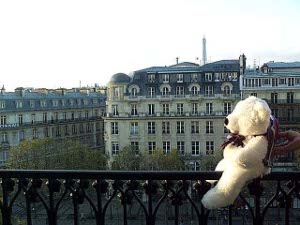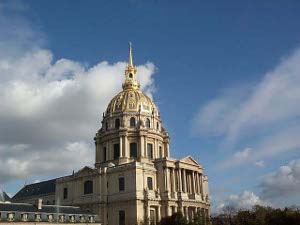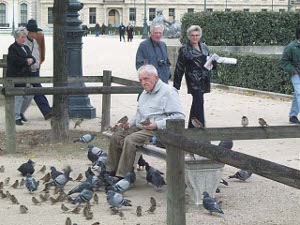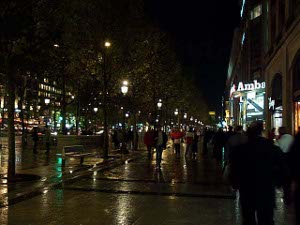 Cuddles and the Champs Elysees
Cuddles and the Champs Elysees
Cuddles woke us up early, because the sun was shining and the sky was blue. We showed her some sights from our window and took her picture, then with our Paris map in hand we headed out in a different direction than we've walked before.
 Cuddles and the Champs Elysees
Cuddles and the Champs Elysees
The Eiffel Tower popped into view from different directions, so amazingly out of scale. From our hotel room at sunset last night we saw it lit with sparkling lights and later it was golden, with a rotating floodlight (airplane warning?). This morning its iron braces stood out against the sky, and loomed through the trees; turning one corner we got a sudden glimpse of part of a giant leg. We walked past the Palais de Chaillot and then across the Seine until the Eiffel Tower grew so big it seemed to surround us. On the bridge people with fancy cameras were backing up, backing up, trying to capture the whole thing on film. Don't bother, we thought. This is too big for a piece of paper. And still beautiful, long after it was built.
We wandered through the Seventh Arondissement, looking at stores and restaurants, and then stopped at a triple museum: War Museum, Napoleon's Tomb, and the Museum of the Order of Liberation, including the Resistance and the Deportation. Actually, our highest priority at the time was la toilette, but museums are always good for that.
What a shocking disappointment these museums were! There was absolutely no evidence of modern curatorship. Here we were in the capital city of a G7  Barges on the Seine
nation, and the museums were simply collections of objects. The architecture and museum display cases were old and apparently had not been updated for decades.
Barges on the Seine
nation, and the museums were simply collections of objects. The architecture and museum display cases were old and apparently had not been updated for decades.
After visiting museums in Denmark, the Netherlands, and Luxembourg describing World War II and the dilemma of the civilian populations in nations occupied by Germany we were interested in learning something about the French experience. The signs told us that the Museum of the Order of Liberation was also the Museum of the Resistance and the Museum of the Deportation.
Instead, the Museum of the Order of Liberation was primarily a paean to Charles de Gaulle. One room, filled with uniforms, letters, swords, busts, decorations, etc., was unbelievable. There was a huge display case with all de Gaulle's decorations in it. Our reaction when looking at this was, this is  Hotel Les Invalides
absurd! No one could wear even a quarter of all these decorations. All we could think of was ego, ego, ego. There were even two display cases of envelopes addressed to de Gaulle by famous wartime figures: Eisenhower, Churchill, Roosevelt, etc. The message here was apparently, see what famous people wrote to de Gaulle.
Hotel Les Invalides
absurd! No one could wear even a quarter of all these decorations. All we could think of was ego, ego, ego. There were even two display cases of envelopes addressed to de Gaulle by famous wartime figures: Eisenhower, Churchill, Roosevelt, etc. The message here was apparently, see what famous people wrote to de Gaulle.
Of course de Gaulle's ego is well-known, but it was amazing to us that the French would even permit an exhibition such as this which glorified the man to the point of idiocy. We believe the museum was planned and executed by fanatical de Gaullists, and not by any responsible curator who cared a whit for truth and education. [De Gaulle created the Order of Liberation, and possibly the members of the Order were responsible for the museum.] We think that de Gaulle's major contributions to France came after the war, when he established and presided over the Fifth Republic, and helped France on its way to postwar recovery.
There was no quantitative discussion -- how many troops, how many resistance fighters, how they were organized, what they did, how they were commanded, when these activities occurred, etc. Instead there were buttons, armbands, flags, with small, old, typed captions that made no attempt to relate  Lyautey's tomb and lady
the objects to each other.
Lyautey's tomb and lady
the objects to each other.
There was no mention of the Vichy government, as if this was not even part of the French experience in the War. After seeing what a fine job the Netherlands did in honestly describing their experience in World War II, we felt France was covered in shame by this museum. The Museum of Deportation was filled with ghastly relics of those who had died in German concentration camps, with virtually no information on how they had got there. Apparently the French cannot admit that any Frenchmen were Nazis, collaborators, or anti-semitic. To take this position is to deny the truth. For example, Marshal Hubert Lyautey, whose tomb we observed at Les Invalides, ruled Colonial Morocco and became a French Fascist leader.
Napoleon's tomb is in the Dom Church along with the tombs of Vauban, Foch, and Joffe. The effect is unsettling, to say the least: the ceiling paintings and the altar provide a religious setting for The Tomb which is placed on a lower floor so that visitors gaze down through a huge circular opening to the floor below where his tomb rests on a mighty platform. Michelin informs us that Napoleon's body actually resides within five nested coffins and inexplicably gives Napoleon's Tomb three stars (worth a journey to see). Once again there is absolutely no curatorship; no explanation as to who Napoleon was, what he did, or why he should be honored. School groups were being led to see Napoleon's tomb. What message were they getting? Here is this warlord buried in a church so worship him? Who were the other guys and who cared? If the school teachers think that the kids know all about Napoleon, they'd better think twice, because school kids everywhere know less than you'd think, especially about history.
 Napoleon's tomb
Napoleon's tomb
To be honest, we did not see much of the war museum (the third member of this trio of museums). After seeing a corridor filled with mannequins wearing different uniforms and display cases of toy soldiers in different uniforms, we didn't have the heart.
Also to be honest, we don't know if there are better museums in Paris or elsewhere in France covering these subjects. We do know that France has great museums, because we have visited the Louvre and the Quai d'Orsay on previous trips to Paris.
We are reading a very interesting and informative book entitled France in the New Century: Portrait of a Changing Society, by John Ardagh. He points out that France has a tradition of a very powerful and highly competent civil service. Until recently, most large businesses were state-owned. The French have learned to look to the government to solve their problems. The best young French students go to the most elite universities and post-graduate schools they can, because attendance alone can ensure a successful career. The "enarques" (named after ENA, the Ecole Normale Administratif) have risen to the top government positions, from which they often transition to top positions in politics or business. Modern enarques include Chirac, Jospin, Aubry, Rocard, Giscard, Balladur, and Juppe.
 Friend to birds
Friend to birds
Two words describe this situation: elitist, and egotistical. Many of the enarques have made brilliant contributions to France in the postwar years, and they are legitimately respected for their high capabilities. But a population which believes that they are safely in the hands of a meritorious elite can be blinded to the truth. Developing cult figures such as Napoleon and de Gaulle can be inconsistent with a search for political truth. It is quite remarkable in a nation which has produced great scientists, philosophers, writers, mathematicians, etc. Trust in the enarques can also lead to great disillusionment, which is a significant problem in France today, due to the revelations of unethical and criminal acts by persons in high places.
From the point of view of an American, in order to recover from "enarquism" France must spread its educational efforts more widely, so that no elite becomes so privileged that it thinks itself above the law. (Which is not at all to imply that America is beyond reproach.)
Now it was time for lunch. Several years ago, Bob Licklider introduced us to the idea of Michelin Red Guides, but we've never been in one country long enough to try to use them. We can now testify that this is an indispensible traveler's companion.
We had selected some Parisian restaurants rated Bib Gourmand, that is, good food at moderate prices.
 Tuileries Garden
Tuileries Garden
We were the second customers of the day at Le Restaurant de Champ de Mars, where we had a three-course delicious lunch (our main meal--works best for our tummies and wallets). The food and the service were exceptional. The guide book says this is a touch of Old France: at the end of the meal we had an Old French experience.
We paid by credit card and added a tip on the credit card receipt above the signature. The waiter appeared pleased but somewhat stunned, and conferred at some length with Madame the manager. He then reported that thank you very much, but the credit card had already been billed (sans tip) and couldn't be changed. No problem, we decided, if he gave us back the bill we would scratch out the tip and leave a cash tip. At this point Madame inexplicably grew quite stubborn and rude. She wouldn't return the bill for us to cross it out, and wouldn't discuss it. We were quite sure it was a failure of communication, but she refused to communicate further. Madame pointed out that service was included. We found ourselves feeling as though we were talking to somebody who wasn't there.
 Champs Elysees at night
Champs Elysees at night
After thinking about it, we believe we experienced that intransigence and lack of empathy which cause so many Americans to dislike the Parisians so intensely. What makes it the more odd is that she, and the rest of the staff, were impeccably courteous and diligent about the service of lunch, yet couldn't care less about our final satisfaction. Perhaps it is another example of the bureaucratic mentality: she may have thought we should accept her procedure unquestioningly.
We're expecting better relationships with French people in smaller cities because we've been told they are warmer and more welcoming to tourists.
As we resumed our walk, still occasionally muttering and gesturing and re-running the episode, we began to notice French police at street corners. Two, three, then more, until we reached the middle of a block and found the street barred and guarded by a dozen or so young police types in riot gear.
It was a Manifestation. A group apparently representing various social service professions (including the police) was demonstrating. They had banners and a big balloon and some flags and some chants. Dozens of police blocked all the streets through which the demonstrators could approach the buildings of the government ministries. We watched one confrontation, with additional police  Une Petite Manifestation
being called up to block the demonstrators. There was an amicable discussion and the demonstrators abandoned their attempt to take their message directly to the government. Instead, they formed up in a side street, hemmed in by the police, waited for all the photographs they could convince the media representatives to take (we took a bunch too), then marched a block or so down a wider street. The cars immediately all began honking their horns and driving on the wrong side of the street to get around the marchers. The police watched amiably. A few shopkeepers stared bemusedly. The march began to lose coherence as it turned another corner, and we proceeded on our tour of Paris.
Une Petite Manifestation
being called up to block the demonstrators. There was an amicable discussion and the demonstrators abandoned their attempt to take their message directly to the government. Instead, they formed up in a side street, hemmed in by the police, waited for all the photographs they could convince the media representatives to take (we took a bunch too), then marched a block or so down a wider street. The cars immediately all began honking their horns and driving on the wrong side of the street to get around the marchers. The police watched amiably. A few shopkeepers stared bemusedly. The march began to lose coherence as it turned another corner, and we proceeded on our tour of Paris.
An inquiry later at our hotel confirmed what Ardagh had written: small demonstrations are an almost daily occurrence in Paris. This was just the first time we had witnessed one, and we thought it all good sport, although the riot police certainly were quite well-prepared for a more serious event.
By this time it started to sprinkle, we were getting tired, and a cold wind was blowing, so we popped into the Metro and rode two stops back to the hotel.